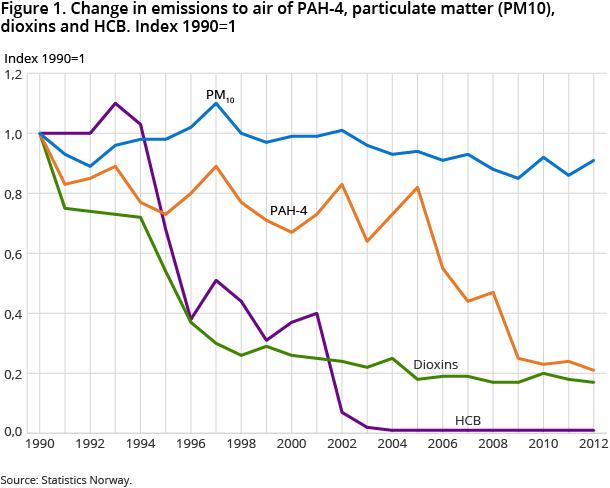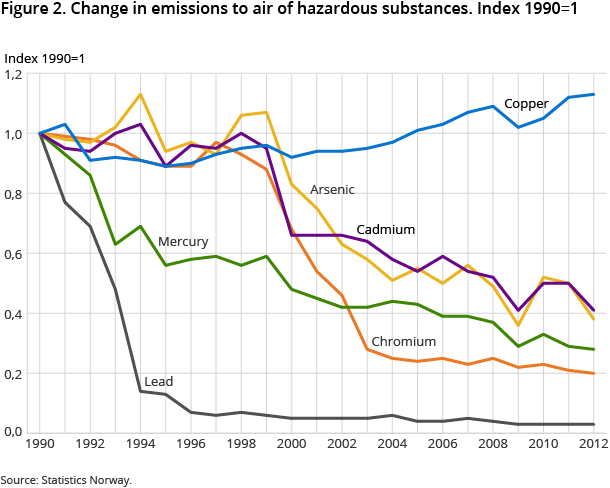Content
Published:
This is an archived release.
Fall in hazardous substance emissions from manufacturing
The emissions to air of most hazardous substances decreased in 2012. The decrease was mainly due to closures and temporary shutdowns in the manufacture of pulp and paper.
| 2012 | Change in per cent | ||
|---|---|---|---|
| 2011 - 2012 | 1990 - 2012 | ||
| 1Does not include ocean transport and international air transport. | |||
| 2HCB figures were published 29 January, but lacked in this table. | |||
| Lead (kg) | 5 570 | -10.3 | -97.0 |
| Cadmium (kg) | 477 | -18.0 | -59.4 |
| Mercury (kg) | 396 | -4.3 | -72.2 |
| Arsenic (kg) | 1 326 | -24.4 | -62.2 |
| Chromium (kg) | 2 520 | -8.3 | -80.3 |
| Copper (kg) | 29 018 | 0.6 | 12.7 |
| Particulates - PM10 (tonnes) | 45 924 | 5.6 | -9.2 |
| PAH-4 (kg) | 7 641 | -13.7 | -79.1 |
| Dioxins (g) | 22 | -4.2 | -82.7 |
| HCB (g)2 | 1 259 | 0.2 | -99.0 |


The emissions of most heavy metals, arsenic , dioxins and PAHs (polycyclic aromatic hydrocarbons) to air decreased in 2012. The decrease was due to reduced activity in some areas of manufacturing and a fluctuating content of contaminants in raw materials and reducing agents used in metal production.
Reduction in most emissions after 1990
The emissions to air of several hazardous substances including PAHs (polycyclic aromatic hydrocarbons) have been considerably reduced since 1990. The cause of the decrease since 1990 is primarily reduced emissions within manufacturing and mining. Cleaning measures, changes in production procedures and lower activity in some industries have all resulted in reduced emissions.
Norway has a national target to reduce emissions compared with the emission levels in 1995. Internationally, we have an obligation to reduce emissions of selected hazardous substances compared with 1990.
Emissions of particulate matter increased by 6 per cent
Emissions of particulate matter (PM10) were 49 500 tonnes in 2012, which is a 6 per cent increase from 2011. Fifty per cent, or about 23 000 tonnes, of the emissions of particulate matter (PM10) in 2012 came from wood-burning. The wood consumption increased by 5 per cent from 2011 to 2012. At the same time, the calculated emissions of particulate matter from this source increased by 4 per cent. This is due to a higher share of wood stoves with new technology. Process emissions from manufacturing and mining amounted to 9 700 tonnes, or 21 per cent of the emissions of particulate matter in 2012. Motorised equipment and road dust/tyre wear were responsible for 7 and 4 per cent of the emissions respectively.
Decreased emissions of dioxins
In 2012, 22 grams of dioxins were emitted to air. Since 2011, emissions of dioxins have decreased by 4 per cent. The emissions have been reduced by more than 80 per cent since 1990. A large proportion of this reduction is due to the shutting down of one industrial plant and one mine. In addition, emissions from energy supply were reduced by 94 per cent from 1990 to 2012 due to the introduction of cleaning measures at waste incineration plants. Since 2005, the emissions have been relatively stable. The most important emission source in 2012 was wood-burning in private households, which contributed with 36 per cent of the total dioxins emissions. Combustion emissions from navigation and process emissions from metal production accounted for 19 and 7 per cent of the total respectively.
Reduced emissions of PAH-4
Process emissions in aluminium production are the most dominant source for PAH-4 emissions, and contributed with 50 per cent of the total PAH-4 emissions to air in 2012. The figures for 1990 and 2011 were 84 and 58 per cent respectively. The PAH-4 emissions decreased primarily because of the discontinuation of Soederberg technology in the aluminium production. Wood-burning contributed to 24 per cent of the emissions in 2012, compared with 7 and 21 per cent in 1990 and 2011 respectively. Road traffic contributed to 15 per cent of the emissions in 2012. This includes both exhaust and tyre and brake wear.
Reduced emissions of HCB
Statistics Norway has developed a national HCB – hexachlorobenzene emission inventory for the period 1990-2012. Estimated total emissions in Norway of HCB in 2012 were 1 300 grams. The most important source for emissions of HCB in 2012 was road transport, which was responsible for 52 per cent of total emissions. Emission of HCB has decreased by more than 99 per cent in the period 1990-2012 mainly due to the closure of magnesium production.
Reduced emissions of mercury, lead, chromium, arsenic and cadmium
The reduction in emissions can be explained by closures and temporary shutdowns of several large companies in power intensive industries during 2012. The biggest reduction can be seen in the manufacture of pulp and paper and the manufacture of metal and basic chemicals.
Emissions of mercury were 0.4 tonnes in 2012, which is a 4 per cent decrease from 2011. The main reasons for the decrease are reduced emissions from the manufacture of pulp and paper and production of ferroalloys. The most important sources of mercury emissions are manufacturing and mining and combustion without energy utility, which comprises cremations. The emissions have been considerably reduced since 1990, and have been relatively stable since 2000.
In 2012, 5.6 tonnes of lead were emitted to air. This is a reduction of 10 per cent since 2011. Emission from brake wear is the dominant source for emissions to air of lead.
Emissions of chromium were 2.5 tonnes in 2012. Combustion in the wood processing industry is the most dominant source of chromium emissions to air. Emissions from combustion in the wood processing industry have been reduced by 21 per cent since 2011.
Emissions to air of cadmium totalled 0.5 tonnes in 2012. Wood-burning in private households and combustion in the wood processing industry, mainly burning of refuse wood and waste liquor are the most important sources of emissions of cadmium to air. In 2012, these sources contributed with 29 and 18 per cent respectively. Cadmium emissions from wood processing industry have been reduced by 36 per cent since 2011. Cadmium emissions have been reduced by almost 60 per cent since 1990.The main reason for this is reduced emissions from production of iron, steel and ferroalloys due to emission reduction efforts and the closing down of production plants.
In 2012, 1.3 tonnes of arsenic were emitted to air, which is a 24 per cent decrease since 2011. For the past few years, the variation in arsenic emissions has been due to varying arsenic content in raw materials and reducing agents used in metal production. The total arsenic emissions have been reduced by 62 per cent since 1990.
Emissions of copper are stable
Emissions of copper were 29 tonnes in 2012. Copper emissions have increased by 13 per cent since 1990. Emissions from brake wear are the dominant source for emissions to air of copper.
Differences between emissions to air and local air quality Open and readClose
The figures calculated in these statistics are emissions to air, i.e. the amount of particulate matter coming from chimneys, exhaust pipes etc. This is not to be confused with local air quality or concentrations, which is the amount of substance that is actually inhaled by humans. In concentration calculations, the fact that humans are more exposed to some emission sources than others is taken into account. For instance, emissions from wood-burning are often emitted from chimneys, and do not affect local air quality to the same extent as exhaust emissions. For this reason, one tonne of particulate matter from wood-burning is less significant to concentrations at ground level than one tonne from exhaust.
The health risks associated with local air pollution depend on how high the concentration of the polluting substance is, and on length of exposure.
Recalculations in dioxins Open and readClose
The time series for dioxins from ferrosilicon and silicon production have been recalculated for the period 1990 to 2011. The new calculation results in lower emissions for all years than in earlier calculations.
The statistics is published with Emissions to air.
Contact
-
Statistics Norway's Information Centre
E-mail: informasjon@ssb.no
tel.: (+47) 21 09 46 42
